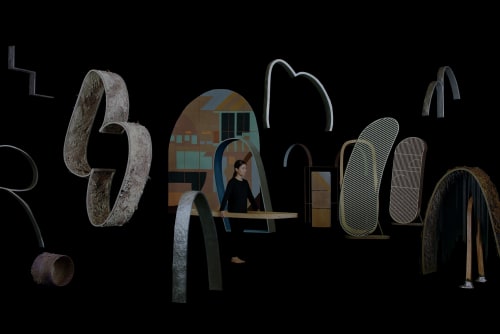Suki Seokyeong Kang’s latest exhibition, mounted at the Leeum Museum of Art in central Seoul, offers a multi-sensory journey through the artist's innovative interpretations of Korea's visual traditions of space.
The show unfurls like a three-dimensional “sansuhwa” (traditional Korean landscape painting of mountains and water). Yet, instead of delicate ink brushstrokes, what adorns the museum’s grand halls and lobby are mountains crafted from metal, leather and “hwamunseok” (Korean handwoven reed mat); abstract minimalist scenes of day and night stretched across the floor and walls; and pastel-colored pillars with comb-patterned slits.
Titled “Willow Drum Oriole,” the exhibit is Kang’s largest solo museum show to date, bringing an array of more than 130 pieces across the mediums of painting, sculpture, textile, installation and video.
The multidisciplinary artist is best known for invoking classical Korean cultural heritage ― including poetry, music, handicraft and dance ― and decoding its aesthetic language to then articulate, in her own subversively minimalist way, the contemporary notion of space and individual’s position within it.
The basic building block of her “Jeong” series is grid, which draws inspiration from “jeongganbo” ― a 15th-century Korean musical notation that was considered the first East Asian system to convey rhythm and pitch using square frames.
In the artist’s eyes, each square, known as “jeong,” was more than just a physical shape; it was a conceptual framework that rendered the intangible elements of sound, movement, time and space in a tangible visual form.
Her “Jeong” series thus explores various interpretations of the grid. It sometimes manifests itself as a canvas frame or a three-dimensional installation. Alternatively, it operates as an overarching compositional system, partitioning the entire exhibition space.
Kang delves deeper into the concept of grid-based space division and its broader sociopolitical implications through her “Mat Black Mat” and “Mat” series.
Here, she subtly references “Chunaengmu” (dance of the spring oriole), a one-person royal court dance from the Joseon Kingdom era (1392-1910). The historical dance is characterized by a distinctive choreography, which restricts the female dancer to restrained movements within the confines of a small rectangular woven mat called hwamunseok.
The artist takes this reed mat, used as a stage for a single performer, and reinterprets it as “jari,” or the limited space each individual occupies within societal power structures.
“For Kang, the mat symbolizes the extent of space ― or the sphere of action ― that can fully bear the weight of one’s own body, both literally and figuratively,” said Kwak June-young, curator behind the exhibition.
Like “Jeong,” the “Mat” series takes many different forms in the show ― suspended in mid-air, folded in half, rolled up, framed in steel or even draped over other pieces like skin.
Among the standout pieces are Kang's anthropomorphic sculptural entities, “Grandmother Tower” series. The series earned her the prestigious Baloise Art Prize at Art Basel in 2018 and brought the artist international recognition.
These sculptures, with their gracefully hunched postures, are an abstract portrait of her own grandmother during her final days. By carefully stacking round steel frames wrapped in threads, Kang constructs a delicate skeleton that maintains its own balance.
This artistic endeavor stands as a touching tribute to the enduring strength found in women during their later years, a testament to resilience in the face of human frailty.
The exhibition also features Kang's latest “Mountain” series.
This series takes its cues from classical “jinkyung sansuhwa,” a form of “true-view” landscape painting representing real-world environments that the artist has observed, as opposed to idealized or imaginary landscapes.
However, rather than being limited to two-dimensional depictions, her mountains, constructed from glinting aluminum, leather and hwamunseok, are presented either as life-sized sculptures or mobiles hovering above the ground.
“I've been a frequent visitor to the Leeum Museum of Art since my student days, particularly to view renowned ‘sansuhwa’ works. I used to contemplate how people in the past perceived these mountainous landscapes in traditional paintings and how their narratives from bygone eras could intersect with those of the present,” shared the 46-year-old artist.
“While reflecting on these matters, a series of significant life events unfolded, including childbirth and my battle with cancer. It was during this period that the mountains from those old paintings, which had previously appeared as vast, abstract masses to me, suddenly drew closer. They felt like something small and precious.”
By inviting visitors to stroll amongst her ridges, she creates a new dynamic landscape where her tradition-evoking pieces merge with the bodily movements of present-day viewers.
Overall, Kang’s compact exhibition offers a delightfully confounding experience, where a myriad of paintings, sculptures and installations all converge and overlap while narrating their own stories of the past and the present.
And this was precisely Kang’s objective.
“In this show, tens of thousands of orioles have come together to chirp their own stories and share their differences. That’s what art is, in the end ― collaborating and coexisting with others."
“Willow Drum Oriole” runs through Dec. 31 at the Leeum Museum of Art.
—Park Han-sol


